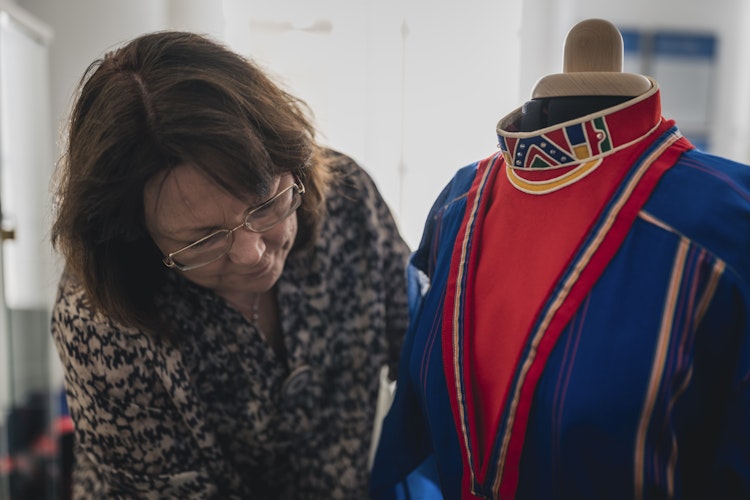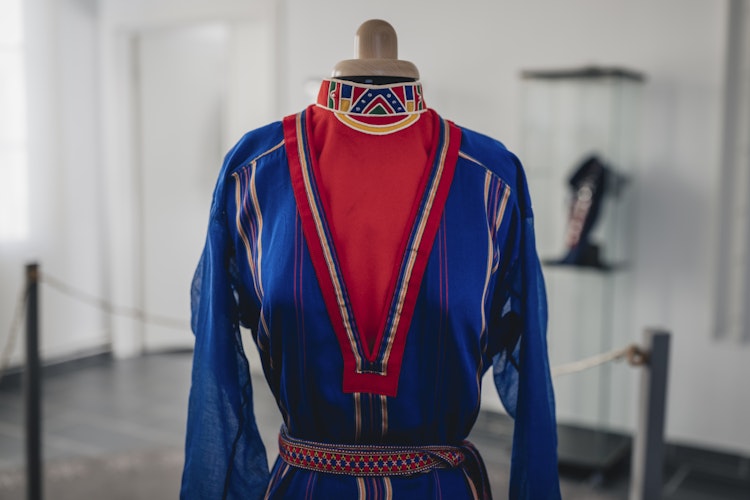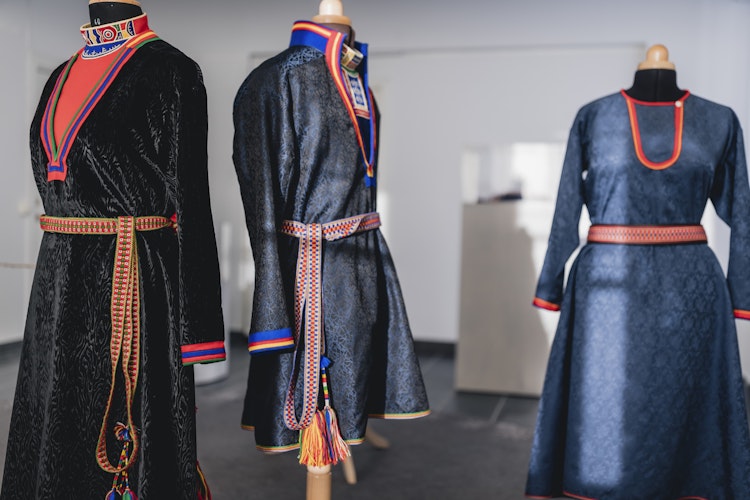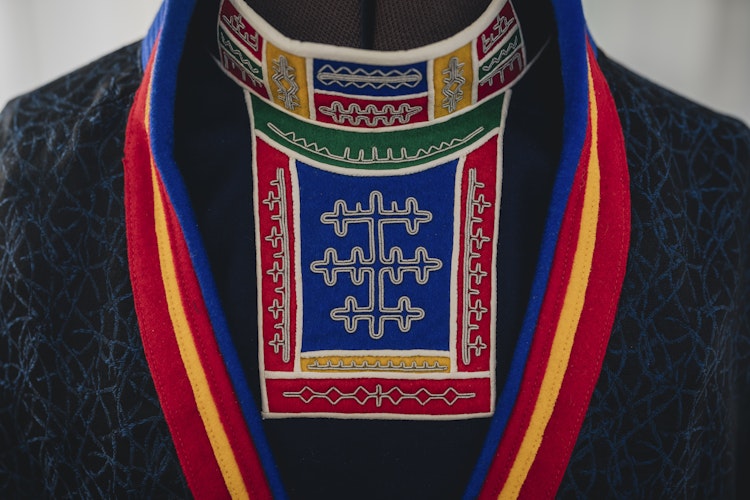

Carl-Johan Utsi and Simon Eliasson
In 2022, it was one hundred years ago that the Swedish State Institute for Racial Biology was established in Uppsala, Sweden. Many ethnic groups and other socially vulnerable subgroups were measured, tested, and photographed in the name of racial biology. The Sami were one of them. In this article, the duodjár and textile artist Katarina Spik Skum describes how she came to use the photographic archive of the Institute for Racial Biology as a source of inspiration for the creation of gábde from the Lule Sami area.
I am sitting in a room filled with photo albums—row after row of heavy, brown, leather-bound photo albums. Each album is marked in a unique way and the titles show that many different groups were examined. “Sami from Jokkmokk Parish”, “Mixed Type Population”, and so on. Hundreds of nameless faces look at me. No one’s age is given on the black-and-white photographs, only neutral numbers which makes it hard to identify the individuals in the pictures. Since I more or less know the approximate year they were photographed, the location, and what clothing they are wearing, I am able to place them on our Sami map. The clothing reveals if a person came from a Northern Sami, Lule Sami or South Sami area1. Warm and excited, I look through one album after the other to see if I can find a familiar face. I recognise a few relatives when they were children, pupils in the nomadic school, as well as others from our Sami village.2 I am sweating and beginning to feel stressed. Photograph after photograph is hastily studied and I utter a few absent-minded comments about their clothing to the others in our group. It is scorching outside, 29 degrees centigrade, and the time for our visit at Carolina Rediviva, the Uppsala University library, is drawing to a close when I finally find the right album.
In an album labelled with a category I had not thought of perusing, I find photographs which probably depict my maternal grandfather’s father. But nowhere am I able to locate any photographs of my maternal grandfather and his brothers or my maternal grandmother’s siblings. I feel a slight disappointment because even though they were photographed, measured, and humiliated, no photographs of them have been preserved. Before I came to Uppsala, I had investigated who in my family had been measured and studied. That can easily be done by using the tables which have been preserved in books, and one copy is located at Ájá, the Ájtte Museum library in Jåhkåmåhkke3. When my visit to Carolina Rediviva comes to an end, my telephone is filled with images from the photographs in the archive. That was my first “real” encounter with the photographic archive from the Institute for Racial Biology. Earlier, I had only seen the photographs on a computer, one by one, compiled on CDs. There they were pulled out of their context and did not appear particularly sensational unless you happen to know the circumstances and history behind them. The images were not even troubling, but rather dreary with faces that look very serious, sad, and frightened. No smiles, no happiness, just gloom.
The Swedish State Institute for Racial Biology—the name itself makes many people uncomfortable. As you acquire more knowledge about the work carried out in the name of scientific research, it gets worse. All kinds of feelings—anger, fury, sadness, hopelessness, irritation, and powerlessness—wash over you. Here we are, the Sami people, with the remnants of an injustice done to the Sami so great, so difficult to understand, and so hard to take in. Among other things, the injustice is manifested in the form of black-and-white photographs, tables, and measuring instruments. Those who would be able to tell us about these events passed away a long time ago, but their stories are told within families and among relatives. We try to interpret, understand, and work through this injustice and place it into different contexts such as art and film in order to understand, move on, and remember.
In this article, I will describe how I have used the photographic archive from the Institute for Racial Biology as a source of inspiration to create gábde from the Lule Sami area. Gábde is the word in Lule Sami for the traditional clothing of the Sami, worn on the upper body.4 The different aspects of my creations, the choices I made, and the reasons for doing them are also presented.
The background and history of the material
In 2022, it was one hundred years ago that the State Institute for Racial Biology was established in Uppsala. Many ethnic groups and other socially vulnerable subgroups were measured, tested, and photographed in the name of racial biology. The Sami were one of them. Everything was done in order to find evidence to support the notion that there are superior and inferior races of people. At that time, many were of the opinion that the superior races should rule the inferior races. Today, the photographic archive from the Institute for Racial Biology consists of 105 albums and 54 folders/envelopes containing 12 123 photos. They are the physical memories from a dark period in Swedish history. In 1981, the Institute of Medicinal Genetics handed over the photographs to the Carolina Rediviva library. The albums and folders have been preserved in the same order they had at the time of the transfer. The albums are in two formats, vertical and horizontal.
The Institute for Racial Biology was established in Uppsala in 1922 following a vote in the Swedish Parliament. The first director was Herman Lundborg. The institute closed its doors in 1956/57, but parts of its activities were carried on by the Institute for Medical Genetics.
Various items from the examinations and measurements have been preserved. Among other things, measuring instruments and measurements compiled in tables have also been preserved. Those who were subjected to the measurements and were photographed are no longer with us, but their traumas—mental and physical memories—are now told by others.


My Road to the Photographic Archive
I came into contact with the photographs in the archive from the Institute for Racial Biology more or less by chance. I had, of course, heard about them and knew that they existed, but I always felt uneasy when they were mentioned. My opinion was that they had nothing to do with me, and I chose not to involve myself with them. Was it self-preservation or a kind of repression that made me do that? I guess I was afraid that they would demand too much from me emotionally. Perhaps I had not acquired enough knowledge, or been sufficiently familiar with the material, for it to make me feel upset or hurt. Or was it maybe me not having heard the personal stories and been affected by them earlier?
Life is full of coincidences and serendipities which sometimes lead you down unknown paths where you don’t know in advance where you’ll end up. In 2010, I was a student at Sami allaskuvla, the Sami University of Applied Sciences, in Guovdageaidnu.4 I was working on my bachelor’s degree in duodje, Sami crafts, and the subject was muoddá, traditional Lule Sami fur coats. I had run into a problem and was at a loss as how to construct the sleeves. For some reason, [Sami artist] Katarina Pirak Sikku and I ended up discussing my problem. Pirak Sikku, who had studied the material from the Institute for Racial Biology for many years, suggested that I should study the photographs in the archive.5 They were photographed with high quality cameras, using glass plates, which resulted in top quality images. I felt a tremendous resistance to the idea of looking into this material and was very skeptical to Pirak Sikku’s suggestion. But she did not give in. Pirak Sikku emphasised the high quality of the images and told me that it was possible to study details on older Sami clothing on the photographs. I felt hesitant about using the photographs and perhaps I was a little bit afraid of what I would find. Earlier I had heard it said that the individuals in the photographs in the archive from the Institute for Racial Biology were naked. Never before had I heard anything positive attributed to these photographs. As time passed, Pirak Sikku’s offer to view the photographs became more and more tempting as I was running out of time to locate information in other ways. Pirak Sikku and I agreed on a date when we could study copies of the photographs together. The day arrived and we met in Pirak Sikku’s studio. There and then, a new path opened onto an unknown dimension of history. It did not take long to realise that it was a treasure trove of Lule Sami clothing history that presented itself to me. Sitting crowded together in front of a computer we were spell-bound for hours studying almost one-hundred-year-old Lule Sami clothing.
Why did I get so engaged and why did I find these images so fascinating? It was the quality, content, time period, and quantity of photographs that made it interesting to me. The quality of the images makes it possible to study—with relative ease—details such as seams, decorations and patterns on fabric. The content was novel as well. Never before had I seen any of the images and that made it possible for me to detect new patterns on sliehpá, dickeys, patterns used on fabric, as well as learning new ways to cut out the pieces for a gábdde. The period the photographs were taken is also interesting since they have to come from the years 1922 – 1935 when the Institute for Racial Biology carried out its measurements. In other words, the photographs were taken during a time when very few people owned a camera and many families possessed no other photographs of their relatives than the ones taken by the Institute for Racial Biology. The sheer number of photographs makes it possible to easily compare and find similarities and differences in today’s duodje.
In spite of this, I worried about using the photographs as a source in my work for my bachelor’s degree. Many were of the opinion that they should not be used and talking about them was a touchy subject. I turned to an older relative, my maternal grandfather’s cousin, to find out what he knew about the photographs. With his moral support, I decided to use the photographs.
My first creations
The clothes we wear and how we use them change over time. As I grew up, the gábdde had primarily become a garment that was used in church and on festive occasions. When my mother grew up, the gábdde was a garment that was used on a daily basis as well as in church and on festive occasions. When this change occurs, development and the transfer of knowledge come to an end. I grew up with the notion that a gábdde was dark blue or black, and very strict and simple in terms of decoration. How it was used was strongly influenced by the followers of Læstadius6 as well as by other factors. In other areas of Sápmi, different colours and patterned fabrics were used for a gábdde, but in the Lule Sami area there were not many who diverged from the general opinion of what a gábdde should look like.
When I studied duodje at Sámij åhpadusguovdásj (the Sami Education Centre) in the early 1990s, I was strongly influenced by tradition and the notion of what a Lule Sami gábdde should look like. But I tried sewing gábdde in other dark colours such as bottle green. I held onto this point of view for many years, but when I ran across the photographs from the Institute for Racial Biology I found evidence showing greater variations of Lule Sami gábde than I was accustomed to seeing. Many have sewn gábde using other colours and fabric patterns without any problems. But I had a problem with it and now I received the help I needed to develop my creativity. It gave me a sense of security to know that the variation of the Lule Sami clothing tradition had been much greater than what I had seen during the 1980s and 1990s. That has made me continue using the photographic archive from the Institute for Racial Biology as a source of inspiration. When I work with the material, I try to avoid being overwhelmed by feelings and you could say that I try to “zoom in” on the garments. I try to not think about the history and context behind the photographs.
One photograph immediately caught my attention—a woman wearing a gábdde made from a kind of fabric I had never seen before! I guessed that the fabric was velvet, and it had a pattern of large rings pressed into it. I went to a local fabric shop to try to find a fabric that was similar to the one on the photograph; and with the expert help of the store owner, I learned that it was known as embossed velvet. After searching for a while, I found an embossed velvet fabric with a leopard pattern in a shop in Stockholm and sewed a gábdde for myself to be worn at the confirmation of one of my sons. For me, this was a huge step in my creative work and I would never have created this gábdde if I had not first seen it on the photographs.
Katarina Spik Skum at work. First four photos by Carl-Johan Utsi. Final three photos by Simon Eliasson.
Reflection on the process and the continuation of the work
Perhaps some of you wonder how it is possible for me to be inspired by the Institute for Racial Biology’s archive of photographs.
When I started using these photographs, I made a conscious decision to “protect” myself from being overwhelmed by emotions that were too powerful. You could perhaps say that I put on “special spectacles” or use a special way of looking when I study the photographs. I excluded photographs with naked individuals and only studied a limited number of photographs. I primarily selected photographs from the Jåhkåmåhkke area in order to limit the material to the garments I wear myself. The photographs I decided to study in detail were the ones containing details on garments that I have found interesting for one reason or another.
More than ten years have now passed since I first came in contact with the archive of photographs from the Institute for Racial Biology. Some of the photographs have served both as a source and as an inspiration during the creation of gábde. Since then, I have primarily focused on patterns on fabrics, decorations on the neckline and the sleeves for the gábdde, and it has developed my creativity in many different ways. I have “hurried slowly” and allowed the work to take its time. Fabric has been purchased and put away until the right time has come to create a gábdde for myself or my family members. We often use these gábde and they have become the ones we prefer.
My work will continue as long as I feel that it is meaningful. In 2022, I have finally sewn a checkered gábdde, a garment sewn using a thinner fabric, inspired by two garments from a photo in the archive. In 2022, it is my goal is to sew at least one more gábdde containing references to the photographs and create a paraphrase of a sliehppá from one photograph in particular. I am doing this even though the photographs are still much debated today, and there are even those who argue that these photographs should no longer be shown publicly. For me, these photographs have functioned as important historical source materials in my studies of Lule Sami clothing. If it is ethical or not is a question that can be debated for a long time and perhaps we will never agree on what is right or wrong in our relation to the archive of photographs from the Institute for Racial Biology.


When it comes to the clothes worn at that time, I am not alone in finding inspiration from these photographs. That has been done before me and others will be inspired by different things from the ones I have found. I am grateful for what these photographs have given me and how they have developed my own creativity. My hope is that my work can be used by other people as well as by Sami society. Perhaps a kind of redress can be achieved when we use the photographs, identify some of the individuals in them, and learn more about the clothes they wore.
The fact of the matter is that I did not find any photographs of close relatives or friends in the archive—no maternal or paternal grandparents, uncles, aunts, or in-laws. This may have coloured my relationship to the photographs. Many who find photographs of family members or relatives find it difficult and painful. I might have reacted that way too if my encounter with the photographs had been different.






